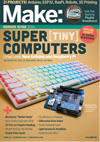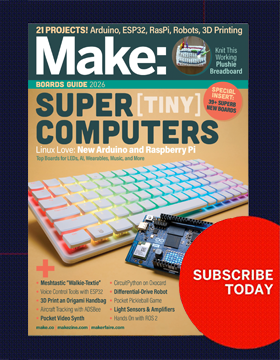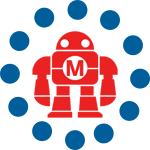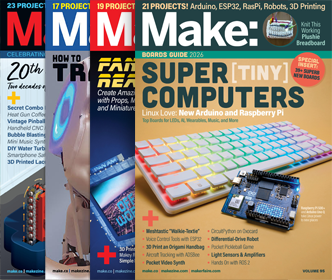
Parker Thomas had an idea for a bag that he turned into a handmade prototype. He launched one Kickstarter, then another to create version one, and then two of the product. He had to figure out how to make it first in Oakland, near where he lives and then in Vietnam. Throughout this process, he found a community who not only supported his product, but gave him ideas about what the next version should be. The third version, which is now on Kickstarter, is based on ideas from that community. They wanted to be able to completely customize the product.

This product is a tool roll, a kind of bag with pouches for wrenches or razors, tweezers, or pliers, hairbrushes or paint brushes, snack bars or tack hammers. Conveniently, it all rolls up neatly for carrying. The Tego Adventure Kit is a bag of interchangeable parts that you can adapt to whatever you want to carry. This episode might get you thinking about what things you like to carry with you and how you carry them wherever you go.
Parker Thomas worked with me about 10 years ago on a makerspace project for Bay Area high schools. Tego is his thing.

Transcript
So you were talking about how this idea came to you.
Parker: So it came to me because it’s a longer story. I’ve always wanted to fly and I’ve found that flying was super expensive and the cheapest way to fly was to own your own airplane and the cheapest way to get your own airplane was to build it.

And so that seemed to me to be flawless logic. And so I set out to build an airplane. I bought it. It was a Van’s aircraft RV8, and I set to work building it. And I was at a time in my life where I had some time on my hands and the freedom to be able to do it. So I spent 3,400 hours over a year and a half building an airplane.
Dale: In a warehouse?
Parker: Started actually near you in Novato at the airport. And then I moved to Louisville, Kentucky, and I finished up on a grass strip that was owned by a guy named Pat Patterson, who proved to be the best teacher that I’ve ever had in my life. And he took me under his wing, so to speak and, it was like every time I made a mistake, he’d made it too and was able to come in and help me.
He was an airframe and power plant mechanic, but more than that, he was just a fantastic teacher. I finished the airplane and he would not let me fly it because he knew it was too much airplane for me as a pilot. So we had a pilot come in and do all the test flights and then gradually hand off to me.
And then he helped me do all the flight planning for my long flights. I flew it through the Bahamas all the way up to Maine, Chicago, Death Valley and Grand Canyon, just all over the country and the places that I went I had to take tools and the airplanes are really sensitive to size and weight.
The easiest way to carry them is tool rolls. So I’ve made these tool rolls out of just denim on my auntie’s sewing machine. They were not anything nice to look at. And carried them with me. So fast forward, almost 12 years, I think. No more airplane. Now I’ve got kids and I had one of those toiletry explosions in a Dopp kit and I was like there’s gotta be a better way to do this.

So I made a tool roll and again pretty rough out of denim. And it worked and I really liked it. So I made a few more until I had something that I liked. And then my friend said, can I have one? And then another one. So the first Kickstarter campaign was, really a shoestring and it raised $56,000. And I thought maybe I’m onto something.
Dale: And what did you promise for that first campaign?
Parker: It was a waxed canvas roll with a leather strap that I had manufactured here in Oakland, down by the airport. Just somebody that I met. There’s actually in and around Oakland, there’s a thriving underground of sewing companies and people that can help you. So once you meet one, it’s like just following the thread.
Dale: And so how long ago was that?
Parker: It was about five years ago.
Dale: So your first Kickstarter was five years ago and then you delivered how many of those things?
Parker: Delivered I think about 2000 and then I ordered another batch and sold those, but what was really intriguing to me was listening to the customers.
Cause they all said I really like what you’re doing and here’s the next thing. I pulled about that time, about fifteen into a Slack channel and started interviewing them. And at first I tried to do it separately, just to have one-on-one conversations with them and I just couldn’t maintain it. I put them all into a room and that’s where the magic really happened is because they would build on each other’s ideas.
And so that led to bringing in a professional design firm for the second one, which launched about two years ago. And that one raised a total of about $150,000 on Kickstarter and Indiegogo.
And then I did it again. I pulled in 35 into a Slack channel and they all started talking amongst themselves and it was really just fun listening to it.
Dale: How was the second one different than the first one?
Parker: It had much more modern materials, a different closure. It had pockets on the flap, cause there was a flap that folded down. It was bigger. I would say it was just an evolution. The modern materials was really helpful because then you can just throw it into a washing machine. And then this one, the first thing that I really uncovered in this group is we like using it for toiletries and we’re using it for gym stuff and art supplies. And Kirsten Berbawy uses that as a maker go bag, like it’s got her tools and knives in it. And they said, so we really want to be able to design our own pockets. Can you please figure that out? And I said, No, you can’t do that. I couldn’t figure out how to do that, but the answer, they actually came up with it themselves was to create sections that slide together. And then you can configure it as big as small with as many pockets as you want. And that’s the version that went live on Kickstarter this morning.
Dale: You sent me a prototype or instance of it. And so just describe it to someone.
Parker: It’s a tool roll and the tool roll has multiple sections. It has seven different sections to it and the sections slide together. One side has a slide on it. And the other side has a series of hooks. There’s only one way they can fit together, but it means that of those seven sections you can put as many of them together as you want in whatever order.
And each section has different pockets on it. So one is a design for cords. One’s designed for tall, skinny stuff. One’s got a pocket for liquids. We’ve got these two sort of pillowcase pockets that we call big mouth pockets that you can put in small compacts for makeup. We went into CVS and started measuring a whole bunch of stuff and basically figured out that there’s five or six meta types of what people carry and then designed pockets for each one of those.
Dale: And the idea here is that you aren’t buying something that’s already customized for you, you’re buying something that has components that you can customize yourself.
Parker: That’s exactly right. When I went to the factory what’s interesting, is that the software to be able to design your own bag, the software is there like it would be non-trivial but straightforward to throw up a website where you could design your own pockets and so forth. The problem is the manufacturing side, because every factory in the world is optimized for runs of 10,000, 50,000. They can’t do one-offs. And so that’s how we landed on the section approach, where basically, if we provide the sections, you would be able to configure it.
Dale: I think your description was pretty good. I think people are going to get this tool roll ideas. That’s actually more evocative to me than bag. Oh, that’s what this is.
Parker: It is a tool roll with sections.
Dale: But you were talking about really the challenges of getting something made like this and the first version you had made locally in Oakland.
Second version as well.
Parker: No second version was
Dale: in Vietnam. This third version is an updated version of the second one and you’ll also make that in Vietnam as well, right? Talk about how you got something made in Vietnam as an individual and entrepreneur.
Parker: I found I think the easiest way is there are intermediaries that can help you and they will either be paid on an hourly basis, or they’ll take a portion of the order size if they are confident enough in your ability to follow through.
I went with an intermediary this time that really helped with the design. And then I dealt with the factory basically myself last time. And I’d say that’s a pretty big overhead, just things you have to learn about or how to do the inspections. And then The order of operations when you make stuff.
And it’s just nice to have people that know things about that. So you don’t have to learn it all at once.
Dale: That’s the role of the intermediary. They take on that interface to the factory.
Parker: Shipping is serious pain, just figuring that out. How many boxes, where does it go? Who do you pay duties to? I actually found Craigslist and Upwork to be huge help. Upwork. I don’t know if you’re familiar with Upwork. But you can put up little jobs and I ended up hiring somebody who ended up being my logistics manager for the whole project. She was fantastic.
Dale: So a virtual company sort of thing. But I’m curious what did you the second time you did this in working in Vietnam, you were doing this without the intermediary. You had an industrial designer create a package for you.
Parker: I had an industrial designer create a tech pack, tech spec that we were able to send. And that’s the language that factory’s speak. It’s got all the specifications of the factory, the paraphernalia that’s going to go on it. And that takes a couple of iterations. And then you end up with what is essentially the golden sample.
That’s the word. And it’s the final version that you’re ready to go into manufacturing with. When you do hit the button and press go on manufacturing, you’ll get one of the very first ones off the line to test as well. But there’s a whole language around that, that I was like –golden sample? What do you mean?
Dale: And how did you find a particular factory?
Parker: How did I find them? It was through an introduction and it turns out that the factory owner is Korean and my wife is Korean. We met face-to-face at Outdoor Retailer and hashed everything out. I got really lucky.
Dale: Outdoor retailer. It’s a trade show?
Parker: It’s a trade show.
Dale: Okay. And this was pre pandemic. One of the things that is interesting to me is the timeline of it. You may have had the idea for a tool roll at some point. You have about five years you started your Kickstarter. So you’ve been working on this at different, not exclusively it’s a — side project for you .
Parker: Side hustle.
Dale: But you keep moving it along, right?
Parker: I think that was one of my big realizations. I could push twice as hard on this and I might be able to move it along 10% faster.
They just take time. It takes time to get samples over there and then back and you just have to accept it. And then there’s Chinese New Year and then there’s something else. And then right now Ho Chi Minh City is shut down for COVID for a month. So there’s just nothing happening. And so if you don’t, if you don’t have the really, it’s like the mental wherewithal.
Exactly. To be able to stand that, there’s just nothing you can do. Every day you just try to inch it forward a little bit more.
Dale: Just shifting a little bit to intellectual property. Any concerns that you had that someone else sees this idea and with a lot more resources and access to a factory just says, I’ll do this.
Parker: I do. I’ve taken some steps to protect this with the utility patent. But I think that a patent is as good as your ability to defend it, which comes down to pockets. And so I think my general approach to this is. If you can run as fast as I can then, great. But I’m going to be innovating as we go along. If you make what I just made, you’re going to be where I was six months ago.
And we’ve already got new products in the pipeline and it comes down to can you brand and market as well? That to me feels like the primary defense against a copycatter.
Dale: I think that’s reasonable. It’s what a common sense tells us. I found interesting is part of your product is your community and with your growing through your Kickstarter and the more you can grow and cultivate that community not only helping you define what those products are, but they’re loyal customers.
I think that the Kickstarter is magical. You get three things, you get validity like a market proof that there’s something out there. And then you get money, which is always helpful. But most of all, you get that tribe. And if you can really engage people, they’ll keep coming back. Tell me, I always been curious about this at the end of your Kickstarter.
How do you take those people that you connected to through Kickstarter? What did you do with them? Are you able to create a mailing list?
Parker: You basically get all their contact information and then it’s up to you. And I wish I could say I did a fabulous job.
There are many other companies that did better, I think if you. If you stay in touch and you’re honest about what’s happening through the whole process of fulfillment, and then, I called them the Tego testers. That’s the group that, that really helped me. And I was surprised when I first sent out the call for the testers to join me in that Slack channel, I got three or four times as many people as I wanted. And what I said was if you’re the kind of person who, whenever you pick up a bag or something like it, you say, God, if only they had just asked me how I would do this, that’s who I want. And there were tons of them and they would compete with each other to here’s how helpful I can be.
Dale: I think in the consumer world, people don’t think about their bags, it’s not until they get into kind of a head space where it’s possible to think about things being different, leads to customization, modifications and things that it just this is the three options I have and that’s it. So you really are opening a new door for people to think about these things.
Parker: Yes. I agree. There is a subculture of carry people, everyday carry people. Those people care a lot. And if you go search for just everyday carry there’s everydaycarry.com. One of the best ones is carryology. And these people are just I would say rabid in a nice way, about how much they care. They try, they’ll support. The question is how do you go from that group to a bigger group? Like they’re the early adopters. So how do you get from there out? I haven’t looked at that yet. I don’t know.
Dale: What drives them? Is it a lot of like lightweight solutions to like sport or outdoor kind of things?
Parker: It’s not any one thing I would say. It’s just that they care, it’s that they get intrigued by it. They’re like, how can I solve this problem in the most efficient way? Lightweight is part of it, but not all of it. They care about the materials and the fasteners and how well it does. And what bags go inside the bags. And where do you put the patches of patches are like a black hole of collectors? It’s just amazing.
Dale: I didn’t formally address this, but your name you named it Tego. I did have it. How’d you come up with that brand name?
Parker: I was looking for something that was literary and Shackleton was too long and it was, I was looking for something that would be tough, durable outdoorsy, and there was a character in Moby Dick named Tashtego. He was a harpooner and I’m a little fuzzy on that when I read Moby Dick, but I think he was the last man to sink beneath the waves at the end of the book. So we started with Tashtego and found that there were about as many pronunciations as there were customers and we just couldn’t get it straight. And at the same time, some customers were starting to shorten it. And so we just switched. Another good idea from customers..

Dale: That’s very good. Rhymes with some other things.
Parker: It does, doesn’t it?
Dale: So today you launched the third Kickstarter in this series. That’s interesting to me that around the same product idea, this is three swings of the bat and each one has done well, at least the first two. Second one did better than the first. And what’s your expectation and raising on this third one?
Parker: I dunno, Dale it’s my, my hope is that I raise enough money that I can make this not a side hustle and a real hustle. If the Kickstarter does well, I’ll probably have to go raise a little money and turn it into a company to be able to do that. There are several companies that have used Kickstarter for all of their product development. The standout is a company called Peak Design and they’ve had 12 Kickstarters. And every time they come up with something new, they go back to their tribe and they raise millions of dollars. If we could be like that, when we grow up, that’d be great.
Dale: Out of this Kickstarter, what would be the number of units you might be producing?
Parker: If we end up with say 10,000 customers that would be pretty incredible.
Dale: But you’re technically still in this kind of small batch manufacturing and one of the results of that is your. A little more expensive than you’d like it to be if you were able to do it at higher volumes.
Parker: Yes. That’s right. They come down. They’ll come down a couple percent every 5,000 that you do give or take,
Dale: but that’s the bet you have.
Parker: You have to think about like the economics of the Kickstarter. you know, It’s not you’re going to walk away with a lot of money. You’re going to end up spending a lot of money on marketing because in many ways it’s an advertising game now. But if you can get your marketing efficiency ratio is the magic number. And if you can get that high enough then you can really scale the campaign.
Dale: To me, some of the lessons that other people can learn is to be patient and it takes a while. You have to always learn. Your designs will change. Your customers will change. Your methods for manufacturing will change and you have learn how to change them.
Parker: Build your tribe and then listen to your tribe. That’s the biggest one.
Dale: Good luck to you with Tego.
Parker: Thank you.
photo credits: Parker Thomas/Tego
ADVERTISEMENT









